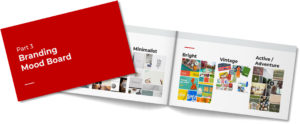Branding extends beyond Fortune 500 companies and trendy startups. A strong, consistently developed brand can help any organization, including federal agencies, build trust with its stakeholders – from customers to employees and beyond. Visual Consultant Mattie Pratt and The Clearing recently helped one large federal agency create and roll out revamped branding that does just that. Read on for the process and results.
The Situation
As our client emerged from the pandemic, they began to implement changes to adapt to their new normal. And as the majority of organizations do, most of those changes were communicated digitally. As time passed, leaders observed that these changes weren’t “sticking” and decided to explore why. That’s where The Clearing came in.
Our team began the engagement with a current state analysis to determine the root cause of the organization’s problem. This included open employee forums, surveys, and stakeholder interviews. What we discovered was a brand – and brand communications – that were inconsistent. That meant employees were getting directives in a variety of formats and a mishmash of branding, damaging credibility and decreasing organizational trust. To put it bluntly, employees shared with our team that it was difficult to take action on requests when they could not trust who was calling the shots or how to prioritize tasks due to the inconsistency from one communication to the next.
Thanks to our earlier foundation of research and feedback, we could easily map a clear path toward the development of a strong brand and guidelines for consistent usage that would drive trust and help leadership meet organizational objectives.
How We Did It
With the agency’s problem identified, we rolled up our sleeves and got to work. Our first order of business was hosting an initial branding session with agency leadership. To better understand the agency’s brand preferences, we reviewed a series of mood boards, soliciting agency leadership feedback. We also discussed how leadership envisioned the future state of the organization to ensure we created a visual identity that could grow with them over time. Combined with our current state analysis, this provided the input we needed to move into the design phase.
Much like prototyping, the design phase is an iterative process. Similar to how The Clearing develops prototype solutions, we kept the organization’s employees at the center of our design process. We took great care to combine the feedback from our current state analysis with the design feedback from leadership to ensure our ultimate goal was met: to build a consistent brand that people could trust to ensure the agency could meet its mission in the new normal.
Once we codified the new branding, we went to work creating the materials that would ensure consistent use – from my perspective, I believe this is the most critical component of building trust. This included everything from a “brand book” – guidelines on usage (what to do; what not to do) – to building easy-to-use templates to make using the new branding in emails, collateral, outside communications, and more as turnkey as possible for team members.

The Impact
Design work – including branding – is often hard to quantify. However, we received inspiring feedback on the new brand in action twofold. The first ties directly to our primary goal – creating a brand that drives organizational trust. Leadership has reported positive employee feedback on the new, more easily digestible and consistent materials – especially communications. As a result, leadership reports spending less time having to repeat communications and reintroduce projects, leaving more time for doing the actual work critical to the American people.
While I’m pleased The Clearing’s design work is delivering on the overall goal, I am just as happy with the second area of impact we heard from the agency. According to agency leadership, by putting the agency’s people at the center of this work we created a brand that people see themselves in and hear their voice in. While the quicker path would have been to create a brand based solely on leadership desires, agency leadership made the right choice to include a broad cross-section of team members in the development process. This helped drive buy-in to the branding change and create built-in passion behind it, making employees feel like they are part of something larger than their day-to-day work operations.
Whether you’re thinking about strategic change or organizational transformation, your branding will play a critical part in driving trust and credibility throughout the process. If you think it’s time to take a fresh look at your organization’s visual identity, reach out anytime.







 The Clearing’s Employee Experience
Improvement model, adapted from Itam
& Ghosh, 2020, focuses on three objectives:
The Clearing’s Employee Experience
Improvement model, adapted from Itam
& Ghosh, 2020, focuses on three objectives: 













